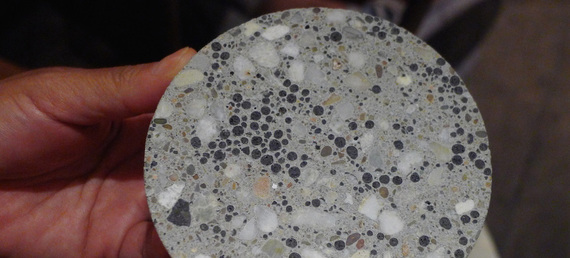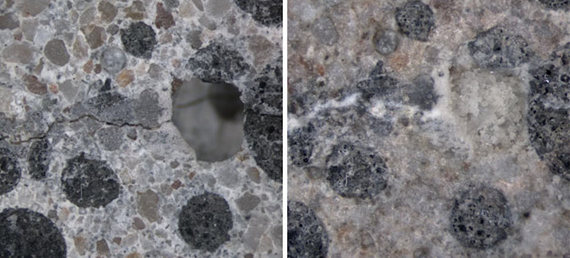
By Don Willlmott
Geology and biology are blending in a fascinating way to create a breakthrough new construction material: concrete that can heal its own cracks. The secret weapon? Bacteria.
At the Delft University of Technology in the Netherlands, professor Hendrik Jonkers has been mixing up batches of "bioconcrete" for six years, adding a special "healing agent" that lies dormant until water starts seeping in through cracks. When that happens, the magic takes over.

Bioconcrete doesn't look all that different from conventional concrete. (Source: Delft University of Technology)
Jonkers works with bacillus bacteria that can survive for decades entombed in the highly alkaline concrete. He also adds calcium lactate to serve as a food source for the microbes. Both the bacteria and the chemical are packaged in capsules made from biodegradable plastic, and that's where they say, embedded in the concrete, until the first cracks start to appear. When water hits the capsules, they open, and the bacteria germinate, feed on the calcium lactate and produce calcite -- otherwise known as limestone, the main component of cement -- and the cracks start to close up.
To date, bioconcrete has been able to heal cracks up to only up to a very slim 0.8 mm wide in about three weeks, but it can also be sprayed into existing cracks in regular concrete to bring its healing powers to bear.
"Nature is supplying us a lot of functionality for free," Jonkers told CNN. "If we can implement it in materials, we can really benefit from it."

In this before-and-after comparison, you can see the whitish limestone healing the crack. (Source: Syn.de.Bio)
The benefits of successful bioconcrete construction are pretty clear. Concrete is the most popular building material in the world, and Jonkers suggests that his self-healing version would need less steel rebar to hold it together, which could bring construction costs down. It would also make an ideal material for the construction of any kind of containment for hazardous wastes, since workers wouldn't have to be exposed to dangerous environments if repairs were needed. Jonkers does admit, however, that in the near-term, it will still be more cost-effective to repair cracks the old-fashioned way.
For now, testing continues to see how bioconcrete performs under extreme temperature conditions and under extreme pressure. If all goes well, it should be ready for the marketplace sometime next year. So how long will it be until we can actually grow buildings?
Visit XPRIZE at xprize.org; follow us on Facebook, Twitter and Google+; and get our newsletter to stay informed.
Don Willmott is a New York-based journalist who writes about technology, travel and the environment for a wide variety of publications and websites.